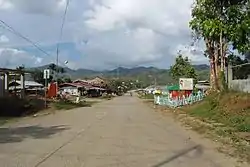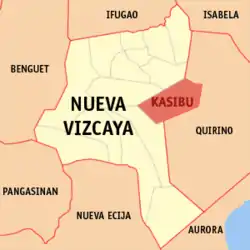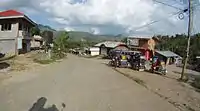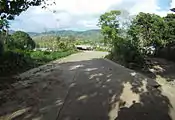Kasibu
Kasibu, officially the Municipality of Kasibu (Gaddang: Ili na Kasibu; Ilocano: Ili ti Kasibu; Tagalog: Bayan ng Kasibu), is a 3rd class municipality in the province of Nueva Vizcaya, Philippines. According to the 2015 census, it has a population of 37,705 people. [3]
Kasibu | |
|---|---|
| Municipality of Kasibu | |
 | |
 Seal | |
 Map of Nueva Vizcaya with Kasibu highlighted | |
OpenStreetMap 
| |
.svg.png.webp) Kasibu Location within the Philippines | |
| Coordinates: 16°19′N 121°17′E | |
| Country | |
| Region | Cagayan Valley (Region II) |
| Province | Nueva Vizcaya |
| District | Lone district |
| Barangays | 30 (see Barangays) |
| Government | |
| • Type | Sangguniang Bayan |
| • Mayor | Romeo C. Tayaban |
| • Vice Mayor | Alberto D. Bumolo Jr. |
| • Representative | Luisa L. Cuaresma |
| • Electorate | 22,720 voters (2019) |
| Area | |
| • Total | 318.80 km2 (123.09 sq mi) |
| Elevation | 873 m (2,864 ft) |
| Population | |
| • Total | 37,705 |
| • Density | 120/km2 (310/sq mi) |
| • Households | 8,415 |
| Economy | |
| • Income class | 3rd municipal income class |
| • Poverty incidence | 17.77% (2015)[4] |
| • Revenue | ₱229,381,922.54 (2016) |
| Time zone | UTC+8 (PST) |
| ZIP code | 3703 |
| PSGC | |
| IDD : area code | +63 (0)78 |
| Climate type | tropical rainforest climate |
| Native languages | Ilocano Gaddang Ilongot Tagalog |
History
Kasibu comes from the Ilongot dialect, which denotes a venue where people settle their differences. By virtue of Executive Order No. 59, signed on 1 January 1926 by Governor General Leonard Wood, Kasibu was established as part of the Municipal District of Bambang. However, by virtue of a Proclamation issued by Governor Leon Cabarroguis in 1933, the Municipal District of Kasibu was reorganized as a Municipal District. On 9 November 1950, Executive Order No. 368,[5] signed by President Elpidio Quirino, abolished the municipal district structure in government and reattached Kasibu to Bambang. The very low population caused the abolition, as residents started to evacuate and abandon Kasibu due to the presence of dissidents from 1950 to 1955. On 9 January 1956, when peace and order was restored, President Ramon Magsaysay issued Executive Order No. 160[6] creating Kasibu as a separate municipality, but losing territorial jurisdiction over some of its barrios specifically Payupay, Belance, Oyao, Teguep, Manacgoc, Pangancan and Munguia, all on the eastern side in favor of Dupax del Norte.
Barangays
Kasibu is politically subdivided into 30 barangays.
- Antutot
- Alimit
- Poblacion (Alloy)
- Bilet
- Binogawan
- Bua
- Biyoy
- Capisaan
- Cordon
- Didipio
- Dine
- Kakiduguen
- Lupa
- Macalong
- Malabing
- Muta
- Pao
- Papaya
- Pudi
- Tokod
- Seguem
- Tadji
- Wangal
- Watwat
- Camamasi
- Catarawan
- Nantawacan
- Alloy
- Kongkong
- Pacquet (Ilongot Res.)
Demographics
| Year | Pop. | ±% p.a. |
|---|---|---|
| 1939 | 1,591 | — |
| 1948 | 693 | −8.82% |
| 1960 | 803 | +1.24% |
| 1970 | 7,952 | +25.74% |
| 1975 | 11,490 | +7.66% |
| 1980 | 15,029 | +5.51% |
| 1990 | 21,425 | +3.61% |
| 1995 | 26,252 | +3.88% |
| 2000 | 28,239 | +1.58% |
| 2007 | 31,515 | +1.53% |
| 2010 | 33,379 | +2.11% |
| 2015 | 37,705 | +2.35% |
| Source: Philippine Statistics Authority [3] [7] [8][9] | ||
See also
References
- Municipality of Kasibu | (DILG)
- "Province: Nueva Vizcaya". PSGC Interactive. Quezon City, Philippines: Philippine Statistics Authority. Retrieved 12 November 2016.
- Census of Population (2015). "Region II (Cagayan Valley)". Total Population by Province, City, Municipality and Barangay. PSA. Retrieved 20 June 2016.
- "PSA releases the 2015 Municipal and City Level Poverty Estimates". Quezon City, Philippines. Retrieved 1 January 2020.
- "Reorganizing the municipalities and municipal districts in the province of Nueva Vizcaya into ten municipalities, defining their boundaries, and abolishing the municipal districts". Official Gazette of the Republic of the Philippines. Retrieved 2021-01-12.
- "Recreating the Municipal District of Kasibu in the Province of Nueva Vizcaya". Official Gazette of the Republic of the Philippines. Retrieved 2021-01-12.
- Census of Population and Housing (2010). "Region II (Cagayan Valley)". Total Population by Province, City, Municipality and Barangay. NSO. Retrieved 29 June 2016.
- Censuses of Population (1903–2007). "Region II (Cagayan Valley)". Table 1. Population Enumerated in Various Censuses by Province/Highly Urbanized City: 1903 to 2007. NSO.
- "Province of Nueva Vizcaya". Municipality Population Data. Local Water Utilities Administration Research Division. Retrieved 17 December 2016.
External links
| Wikimedia Commons has media related to Kasibu, Nueva Vizcaya. |
- Kasibu Profile at PhilAtlas.com
- Philippine Standard Geographic Code
- Philippine Census Information
- Local Governance Performance Management System




